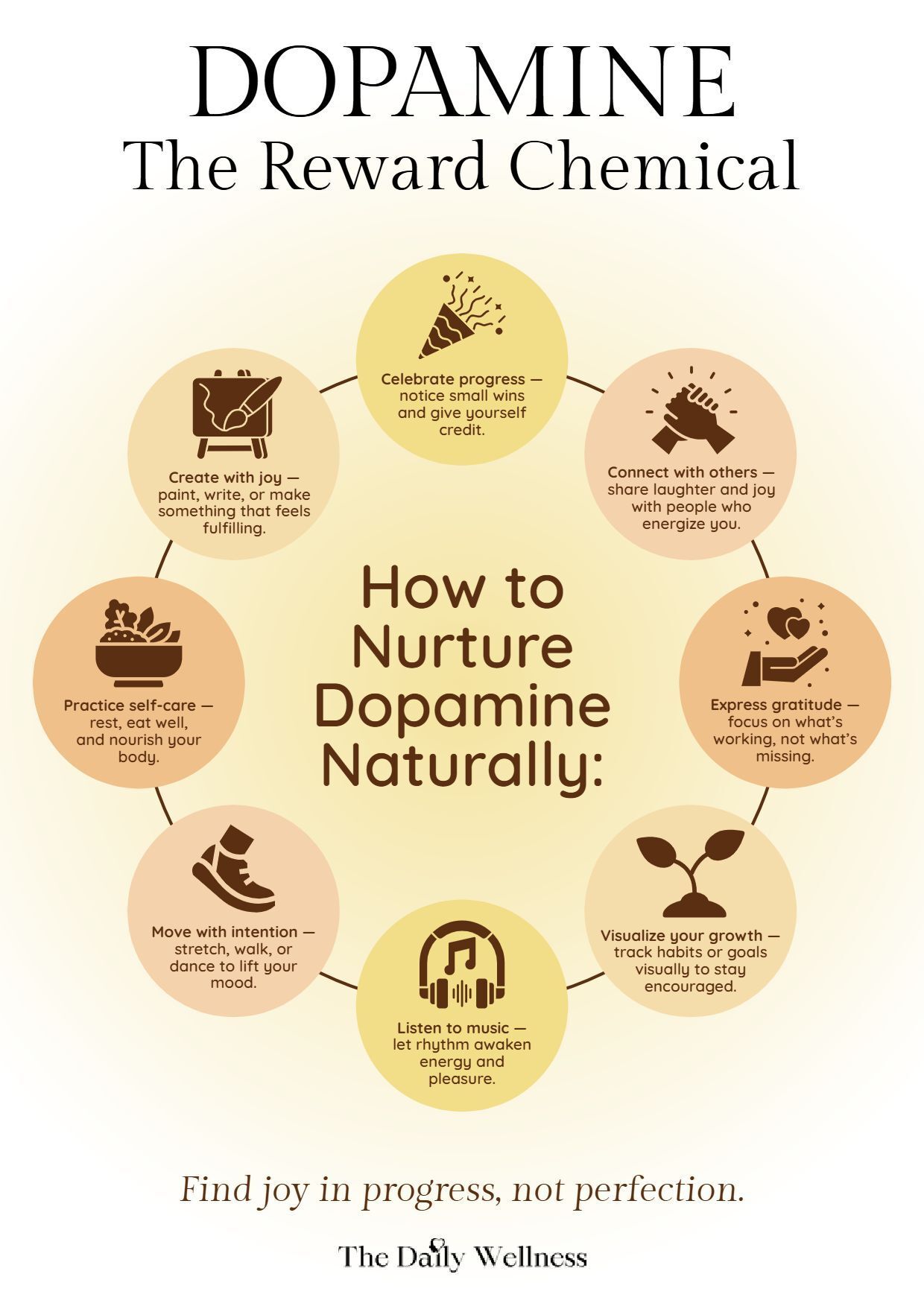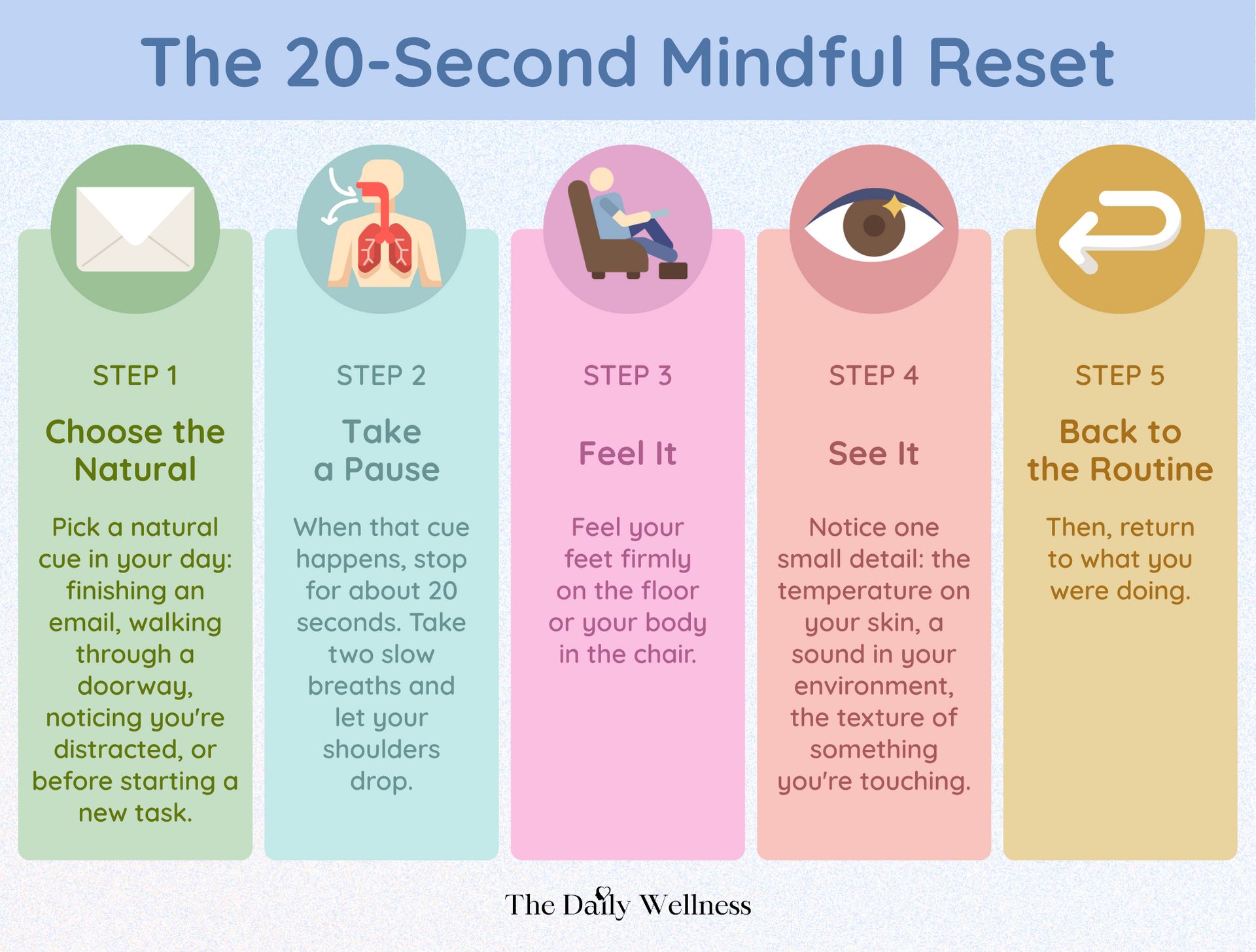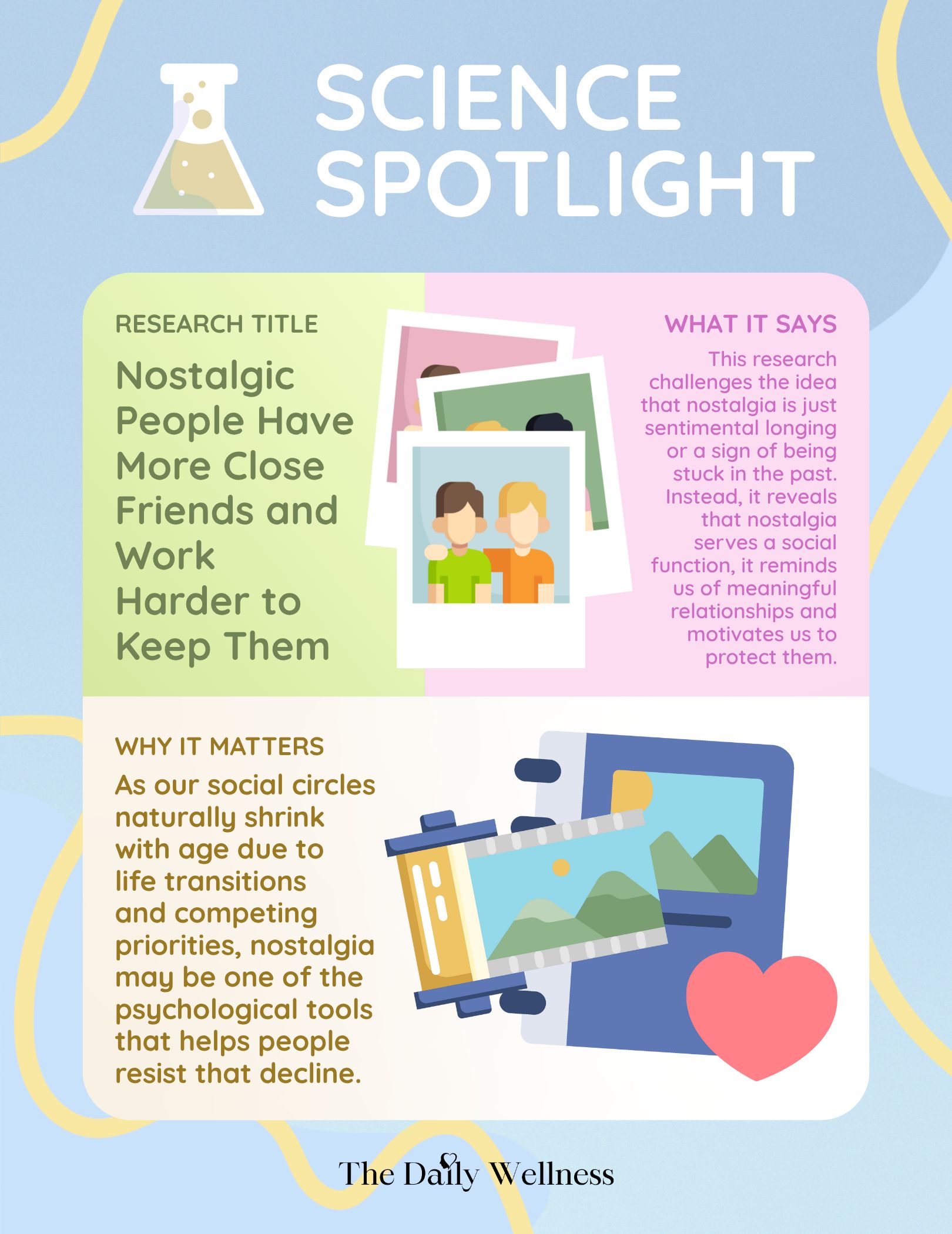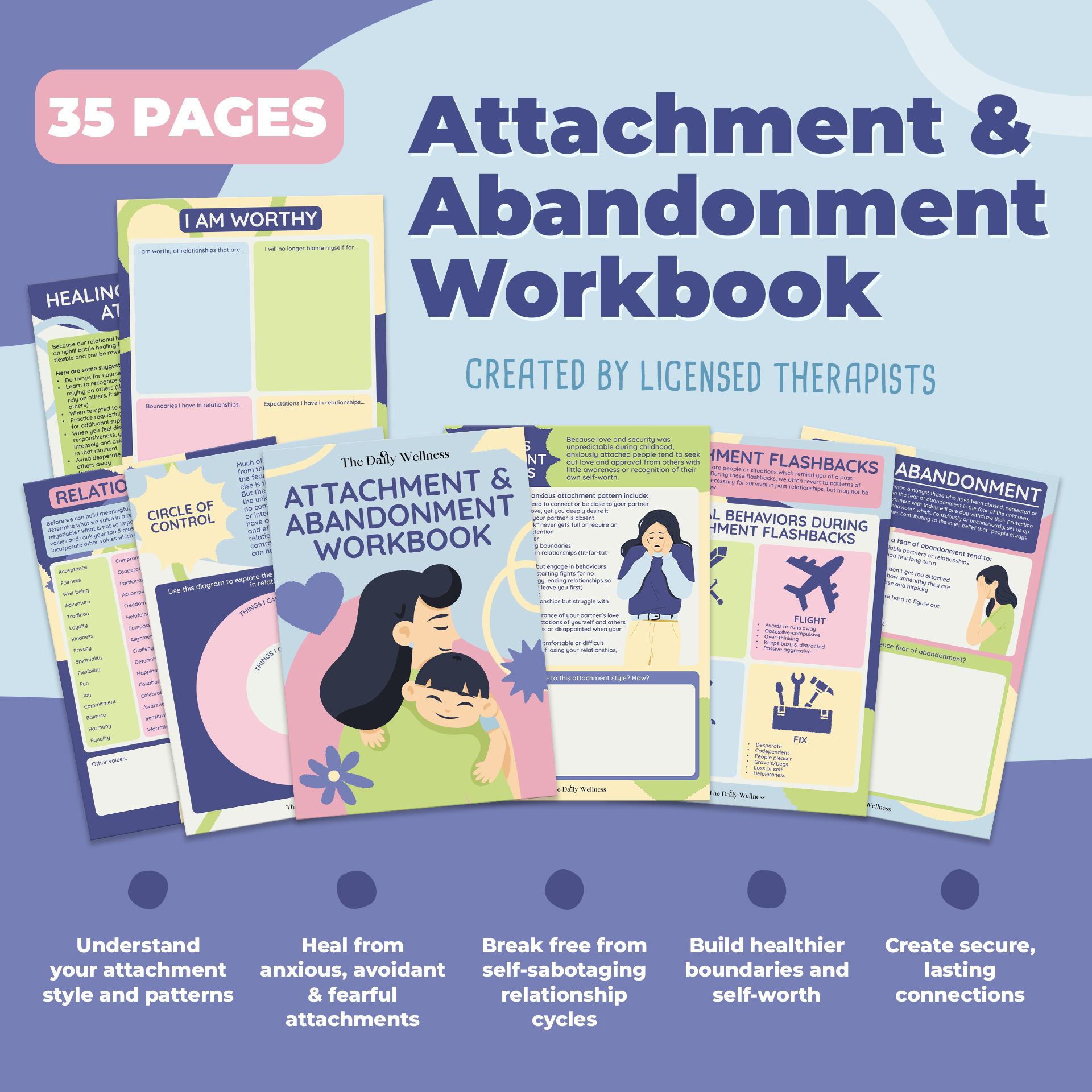When distraction becomes constant, presence turns into a skill we have to relearn. Today, we explore how to rebuild that capacity; to stop drifting through moments, quiet the craving for stimulation, and relearn how to actually feel your own life again.
Today’s Quick Overview:
🔬Science Spotlight: Nostalgia helps maintain friendships…
🛠️ Tool of The Week: The 20-Second Mindful Reset…
📰 Mental Health News: Brain-mapping psychosis; rethinking time itself…
🙏 Daily Practice: Find stillness inside…

Let's check in with your breathing and what it's telling you:
Notice your breath right now. Is it shallow and tight, deep and ready, or somewhere tentative between sleep and waking? Your Monday breathing tells you how you're meeting this week. Shallow breath asks for gentleness, deep breath signals readiness, and hesitant breath just needs time to find its rhythm.
QUICK POLL
Mindfulness works, but the traditional approach doesn't fit everyone. What would make it feel doable for you?
What would make mindfulness feel more accessible to you?
MENTAL HEALTH GIFT
Dopamine Therapy Poster

Discover how to gently boost your motivation and joy with this free Dopamine Therapy Poster. Learn simple, science-backed ways to naturally increase your brain’s “feel-good” chemical, through creativity, gratitude, movement, and mindful self-care. A perfect daily reminder that healing doesn’t require big leaps, just consistent moments of progress.
THERAPIST CORNER

Here's what happens with chronic distraction: Your brain gets conditioned to expect constant stimulation and novelty. When you're eating dinner or having a conversation, your nervous system starts scanning for something more engaging. The present moment feels boring or uncomfortable by comparison, so you reach for your phone or mentally check out.
Underneath the distraction, there's usually something being avoided. Sometimes it's anxiety about the future or regret about the past. Sometimes it's uncomfortable emotions that surface when you slow down. Sometimes it's just the reality that being present requires you to feel whatever you're actually feeling, and distraction offers temporary escape.
But here's what chronic distraction costs you: You lose the texture and richness of your actual life. Days blend together because you weren't really there for them. Relationships feel surface-level because you're only half-present.
The shift back to presence doesn't happen through willpower or harsh self-discipline. It happens through practicing small moments of genuine attention throughout your day. Your brain needs to relearn that the present moment can be interesting, that meals can be satisfying, that conversations can be engaging when you're actually there for them.
One Small Step: Choose one daily activity this week where you practice being fully present, a meal, a shower, a walk, or a conversation. When your mind wanders or you reach for distraction, gently bring your attention back without judgment. You're building a new habit, not trying to be perfect.
Try This:
Notice physical sensations as an anchor, the temperature of your coffee, the feeling of your feet on the ground, the texture of what you're touching
Put your phone in another room during meals or important conversations
Practice the "one thing at a time" rule, if you're eating, just eat; if you're talking to someone, just talk to them
Then say to yourself: "My life is happening right now, not on a screen or in my thoughts. I can return to presence one moment at a time." The goal isn't to never be distracted again, but to catch yourself sooner and choose presence more often.
RESOURCES ON SALE
50% OFF: The Attachment & Abandonment Workbook
Transform from being trapped by toxic relationship patterns to building secure, lasting connections with this comprehensive healing toolkit. Get instant access to therapist-designed exercises that heal childhood wounds, break abandonment fears, and create the healthy relationships you deserve—all through one complete guide you can use anywhere, anytime.
Finally understand why you keep attracting the same toxic relationships – Discover your attachment style and unconscious patterns driving your relationship choices with proven assessments, so you can stop the exhausting cycle of heartbreak once and for all
Stop the draining cycle of people-pleasing and self-abandonment – Learn specific techniques through structured worksheets that help you recognize when you're abandoning yourself for others and develop boundaries that actually protect your energy and self-worth
Transform your deepest fear of abandonment into relationship confidence – Work through targeted exercises that rewire your nervous system's response to intimacy, helping you feel safe and secure even when old triggers surface
Heal the wounded inner child still sabotaging your adult relationships – Connect with and nurture the parts of you that never received the love they needed using guided therapeutic exercises, finally giving yourself the security you've been desperately seeking from others
Break free from anxious or avoidant patterns that push love away – Identify and dismantle the protective mechanisms keeping you stuck in unhealthy dynamics with clear, step-by-step strategies that create lasting change
Build the secure, drama-free relationships you've always wanted – Master practical tools and communication scripts for creating healthy attachment patterns that naturally attract emotionally available partners who can truly meet you at your level
Offer: This discount is only available for the next 48 hours.
*Your purchase does double good: Not only do you get life-changing tools for your own healing journey, but you also help us keep this newsletter free for everyone who needs it. Every sale directly funds our team's mission to make mental health support accessible to all.
TOOL OF THE WEEK
The 20-Second Mindful Reset

What it is: The 20-Second Mindful Reset is a tiny pause you insert into your day, just long enough to take two slow breaths, drop your shoulders, feel your feet on the ground, and notice one detail about the present moment. It's not meditation. It's simply stopping for a moment to interrupt mental drift and bring yourself back to where you actually are.
Why it works: Your brain naturally wanders, especially during repetitive tasks or stress. When you're caught up in worry about the future or replaying the past, your attention scatters and stress compounds. A brief pause gives your prefrontal cortex a chance to step in and calm reactive parts of your brain. You're essentially hitting a tiny reset button that clears mental clutter.
How to practice it:
Pick a natural cue in your day, finishing an email, walking through a doorway, noticing you're distracted, or before starting a new task.
When that cue happens, stop for about 20 seconds. Take two slow breaths and let your shoulders drop.
Feel your feet firmly on the floor or your body in the chair.
Notice one small detail: the temperature on your skin, a sound in your environment, the texture of something you're touching.
Then, return to what you were doing.
When to use it: Perfect for busy days when you don't have time for a full mindfulness practice, when you notice your mind racing between tasks, or when you feel stress mounting but can't step away. It's especially helpful for people who feel guilty about "not meditating enough."
Pro tip: Don't save this for when you're already overwhelmed. Build it into routine moments, after closing your laptop, before walking into your home, when you sit down at your desk. The more you practice when you're calm, the more accessible it becomes when you actually need it.
SCIENCE SPOTLIGHT
Nostalgic People Have More Close Friends and Work Harder to Keep Them

The Research: Researchers studied nearly 1,500 people and found that people prone to nostalgia have more close friendships and invest significantly more effort into maintaining them. Those who scored higher on nostalgia had the most very close relationships and prioritized maintaining them.
A seven-year study found that while people generally became more nostalgic as they aged, those with high or medium nostalgia maintained their close relationships, while those with low nostalgia lost 18% of their close ties.
Why It Matters: This research reveals that nostalgia serves a social function, it reminds us of meaningful relationships and motivates us to protect them. As our social circles naturally shrink with age, nostalgia may be one of the psychological tools that helps people resist that decline. Nostalgic people actively invest in keeping connections alive. Nostalgia increases awareness of how valuable relationships are and creates emotional motivation to nurture them.
Try It Today: If you find yourself feeling nostalgic, don't dismiss it as dwelling on the past. Recognize it as your brain signaling that connection matters to you. Use that feeling as motivation to reach out. Text an old friend you've been thinking about.
If you're naturally less nostalgic and notice your social circle shrinking, try cultivating it. Look through old photos, revisit places that hold memories, or create rituals that honor past relationships. Nostalgia is a tool you can use to remind yourself why relationships are worth the effort.
DAILY PRACTICE
Affirmation
I can carry calm within me even when everything around me is turbulent. External chaos doesn't have to dictate my internal state.
Gratitude
Think of one moment this week when you managed to stay grounded despite stress or disorder around you. That steadiness is a skill you're building, not a trait you either have or don't.
Permission
It's okay to step away from the noise when you need to reconnect with your center. Protecting your inner stillness isn't avoidance; it's self-preservation.
Try this today (2 minutes):
In the middle of a busy or stressful moment today, pause for three deep breaths. Don't try to change the situation; just anchor yourself internally while the external chaos continues. Practice being the still point in the middle of movement.
MENTAL HEALTH NEWS
Cardiff Study Probes Causes of Severe Mental Illness. Cardiff University will collect brain scans, genomics, and social data from 600 people to pinpoint drivers of schizophrenia, bipolar disorder, and psychosis. Finding causes could finally unlock new treatments after decades of stagnation.
What Is Time? Philosopher Says It’s a Mental Projection, Not a Flow
Challenging everyday language and Newton’s “universal clock,” Adrian Bardon argues relativity supports “eternalism,” where all moments equally exist and there’s no objective “now.” Our sense of time passing, he says, is a psychological projection of how minds organize experience, not a feature of physical reality.

Evening Reset: Notice, Write, Settle
Visualization

Picture a snow globe being shaken vigorously. Everything inside swirls in chaos, flakes flying in every direction. But eventually, if you stop shaking it and simply hold it still, everything settles. The flakes drift down, and clarity returns. Tonight you can recognize that you are both the snow globe and the hand holding it. You can't always control what gets stirred up, but you can choose when to stop shaking and let things settle.
Journal
Spend three minutes writing: When did I lose my center this week because I let external chaos pull me out of myself, and what helps me return to stillness when everything around me is moving fast?
Gentle Review
Close your notebook and ask yourself: Where did I stay grounded today despite pressure? What triggers tend to pull me out of my calm? How can I cultivate more internal stillness tomorrow, regardless of what's happening around me?
Shared Wisdom
"In the midst of movement and chaos, keep stillness inside of you." — Deepak Chopra
Pocket Reminder
The world will stay chaotic; your job is to keep a quiet place inside yourself so that it can't reach.
WANT TO CONTRIBUTE TO OUR NEWSLETTER?
Are you a therapist, psychologist, or mental health professional with something meaningful to share?
We're opening up space in our newsletter for expert voices from the field — and we'd love to hear from you.
Whether it’s a personal insight, a professional perspective, or a practical tip for everyday mental health, your voice could make a difference to thousands of readers.
👉 Click here to apply to contribute — it only takes 2 minutes.
TUESDAY’S PREVIEW
Coming Tuesday: What to say when your family expects you to maintain relationships with toxic relatives "for the sake of family," and how to hold boundaries without being blamed for the drama their behavior created.
MEET THE TEAM
Love what you read? Share this newsletter with someone who might benefit. Your recommendation helps our community grow.
*The Daily Wellness shares educational content only and is not a substitute for professional medical or mental health advice and diagnosis. Please consult a licensed provider for personalized care.
